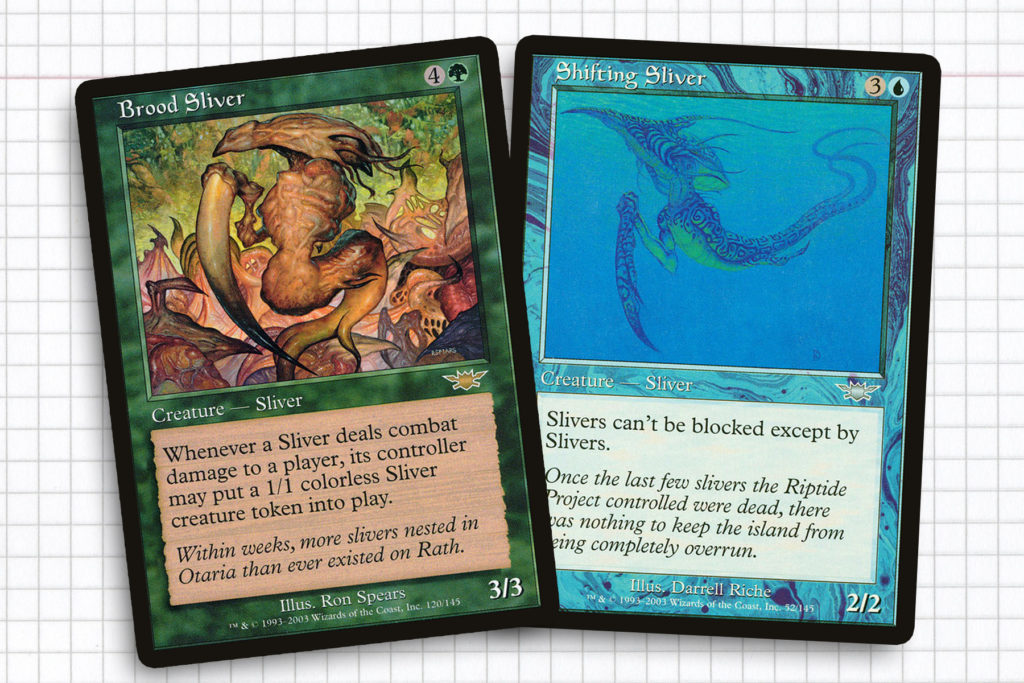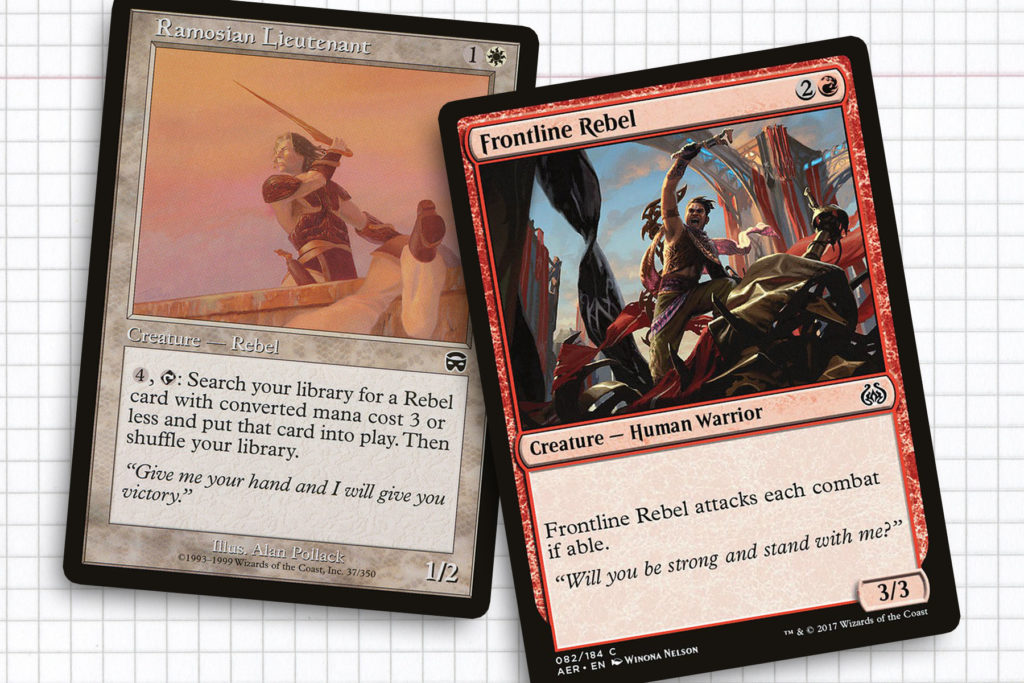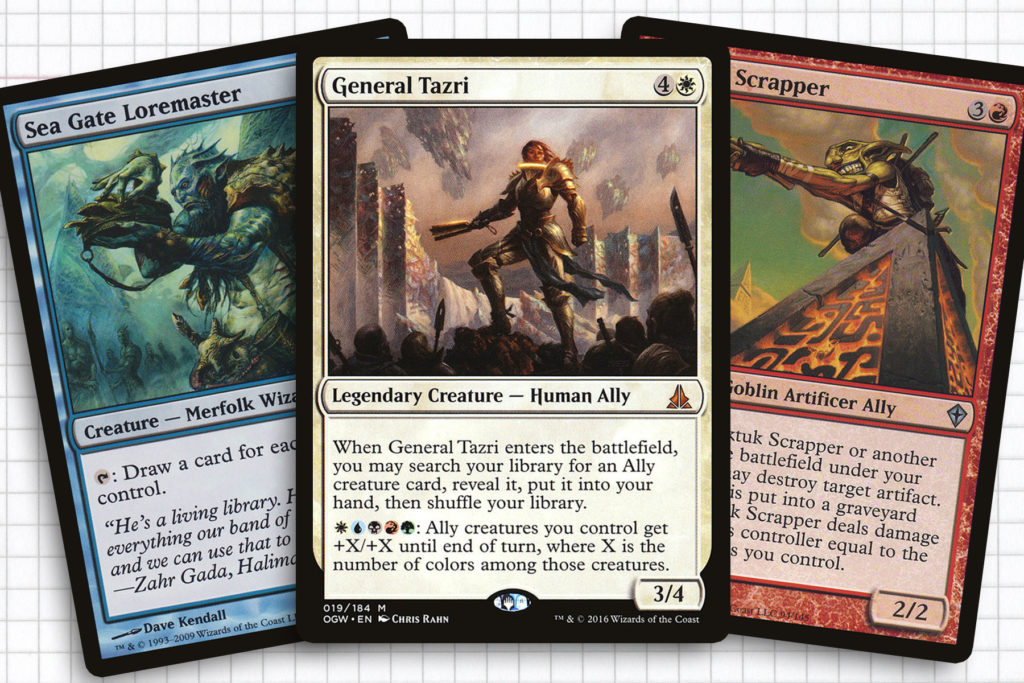Tribal is a very popular casual archetype in Magic: the Gathering. The idea of taking creatures that all share a type and combining them to try to produce something greater than the sum of their parts has existed since the beginning of the game, when cards like Lord of Atlantis and Goblin King motivated players to focus on merfolk and goblins. During the early history of the game these strategies were not viable competitively. While in the last decade that has changed, it doesn’t mean that Magic R&D adequately supports every tribe.
This week, I want to discuss a wider issue I have with the design of creatures, using the disappointment stemming from the lack of the ally creature type in Zendikar Rising as an entry point. Of course, I can’t really cover the topic of allies without talking about the deck I was looking forward to finally updating during our third trip to Zendikar. But we have other topics to touch on before we can get to that. My discussions about the deck are going to be closer to lessons learned than my typical theorycrafting. Stay tuned for that!

His Tribe in My Tribe Too
My love for tribal strategies comes with a very obvious series of biases; chiefly, I started my Magic career just before the release of the tribal Onslaught block. Its second set, Legions, highlighted the silver tribe. As a preexisting tribe, Silvers had a built-in power that was linear enough to make an impact on a young Ryan and solidified the idea of a tribal deck for me. They also recurred enough during my formative years: after collecting all the slivers I could initially, I was rewarded with their reappearance in the Time Spiral block.
Tribal strategies were always something they showed up at kitchen tables. Upon returning after a short lived break from the game, I was surprised to discover that in the Lorwyn–Alara Standard tribes like Kithkin and Faeries made a huge impact on the metagame. A short time later came allies in Zendikar and Worldwake, and I was thrilled to witness a tribal deck with an admittedly limited competitive pedigree, while also being something fun to play in casual sixty-card decks.
From this place of success, Wizards R&D stumbled slightly in my opinion, as they did not design a legendary creature for the tribe during the first trip to Zendikar. This was unfortunate, as Commander was just about to take off and we had to wait six years for a return to the plane. I choose to not be too critical of this mistake though. Commander was not what it would become even a year later, and with Wizards working so far in advance, the insight to design legendary creatures for an untested tribe would have been an incredible called shot.

The Lost Tribes
Wizards made a mistake by not putting the ally creature type in Rise of the Eldrazi, even just as trinket text. From a game design perspective, I can understand why including a creature type into a Limited environment that wasn’t going to support it was viewed as problematic in the short-term. Yet, Stonework Puma already existed, so the thought to include vanilla allies wouldn’t have been unfounded. From this, I see a misstep we are still plagued with today. I may be alone in this, but I wish that creature types could more often exist outside of the mechanical significance they had in their most notable appearance for the purpose of being used more generously.
I believe creature subtypes such as kor and thalakos, or samurai and townsfolk, could all return in their own individual context as nothing more than trinket text for Standard players, but additions to decks ranging from Modern to Commander. As an example, the rebel creature type could have been used on Kalaldesh, especially in Aether Revolt. While it’s nice to honor mechanical continuity for entrenched players, new players did not come with the mechanical baggage that rebels had in Mercadian Masques. As a Commander player this change would have allowed a long-dormant rebel deck to reemerge. Through Aether Revolt, we could have been given two-color rebel generals that had white in their color identities.
Once again, I know that this all comes with bias towards formats that have access to older cards to help reinforce this principle. This is by no means a practice I believe should be used in every set, but I think invigorating a tribe like mercenaries and allowing players to discover that Doomed Necromancer is itself one, can be a fun moment that rewards deck builders taking the time to look for hidden gems.

Sorry for Party Rocking
This brings us full circle back to Zendikar Rising, where Wizards has set aside the ally creature type in favor of the batching mechanic party. In all honesty I don’t hate the idea of party, and I’m really not that salty with this change. To communicate an adventure world, I think it was a good call to encourage players to diversify their creature types. And to include trinket types this go around would have made for some crowded type lines—Wizards even knew this, evidenced by the existence of Tajuru Paragon and Veteran Adventurer. But I still miss allies.
My General Tazri deck has been mostly the same since Oath of the Gatewatch, with some minor updates. Tribal has been used as an overarching theme in multiple products in the meantime, as well as Modern Horizons giving us more changelings. I was really looking forward to overhauling this deck with cards from Zendikar Rising, but for now it will do just fine.
Commander: General Tazri
Creatures: Adaptive Automaton, Agadeem Occultist, Akoum Battlesinger, Angelic Captain, Chameleon Colossus, Changeling Berserker, Chasm Guide, Drana, Liberator of Malakir, Firemantle Mage, Graveshifter, Hada Freeblade, Harabaz Druid, Hero of Goma Fada, Irregular Cohort, Jwari Shapeshifter, Kabira Evangel, Kazuul Warlord, Lantern Scout, Metallic Mimic, Mirror Entity, Ondu Cleric, Reckless Bushwhacker, Resolute Blademaster, Sea Gate Loremaster, Tuktuk Scrapper, Turntimber Ranger, Universal Automaton, Unsettled Mariner, Zulaport Cutthroat
Artifacts: Blade of Selves, Captain’s Claws, Chromatic Lantern, Commander’s Sphere, Darksteel Ingot, Helm of the Host, Herald’s Horn, Icon of Ancestry, Obelisk of Urd, Urza’s Incubator, Wayfarer’s Bauble
Enchantments: Molten Echoes, Oath of Gideon, Retreat to Emeria, Rhythm of the Wild
Instants: Cloudshift, Displace, Eerie Interlude, Eladamri’s Call, Ephemerate, Essence Flux, Ghostly Flicker, Ghostway, Join the Ranks, Kindred Summons
Sorceries: Distant Melody, Farseek, Kindred Dominance, Painful Truths, Skyshroud Claim
Planeswalker: Gideon, Ally of Zendikar
Lands: 3 Forest, 3 Island, 2 Mountain, 9 Plains, 2 Swamp, Bloodstained Mire, Breeding Pool, Canopy Vista, Cinder Glade, City of Brass, Command Tower, Flooded Strand, Godless Shrine, Mana Confluence, Overgrown Tomb, Polluted Delta, Prairie Stream, Reflecting Pool, Sacred Foundry, Seaside Citadel, Smoldering Marsh, Steam Vents, Sunken Hollow, Windswept Heath, Wooded Foothills
One of the reasons I was really hoping to see a favorite tribe of mine return was because I feel like the ally deck at this point is proving to be solved, with tight definition, and not a lot of room for individual nuance. The allies deck is very fun and works at a middle of the road power level that never seems to overwhelm opponents who are interacting with your battlefield. That power level makes for a pretty enjoyable experience when I’m not looking to be the archenemy.
In truth, I’ve found black to be the least helpful of the colors for what I’m trying to do with this deck. That relies too much on a reanimator strategy, which isn’t really facilitated well or needed. Because I’m dipping my toes into so many colors, having colorless lords like Universal Automaton and Metallic Mimic became important for making sure that I could always boost my allies without having to sweat over my mana.
For a long time, I focused heavily on flicker spells, thinking they were my best option for maximizing ally triggers. While this is still true, I began to realize that maximizing on triggers required widening my net of triggers by including things like Captain’s Claws, Kindred Summons, and the overlooked Join the Ranks. This brought my suite of enters-the-battlefield triggering cards from seven to thirteen.
You can see my take on a five-color mana base. In a five-color deck, fetch lands are fair game and just short of required. You will not be able to access all of your mana properly if you don’t give yourself some kind of leg up. Trying to fit all ten shocklands into the deck makes it difficult to keep the mana proportional to its needs, as not every color is equally represented. So I decided to use allied fetch lands in combination with enemy shock lands. This setup might not seem that intuitive, but in practice what I’ve discovered is that a fetchland represents any color of mana without overcomplicating my mana base.
Concluding Thoughts
It’s foolish to believe that Wizards is going to take my advice and completely reinvent their process for assigning creature subtypes. But I hope that we see the occasional use of dormant creature types in functioning ways that allow old tribal decks to become relevant again. And maybe, just maybe, the ally creature type can be one of those on the docket.
I couldn’t put my finger on it at first, but I felt like there was a part of Zendikar that was missing that made this not feel like a set that took place on the plane. But it’s unfortunate that, on our return to Zendikar, we didn’t get either allies or eldrazi. That leaves the set feeling a little lackluster and forgettable to me.
Next week, I’m looking to revisit a deck that has been collecting dust on the shelf for far too long, Gerrard, Weatherlight Hero. Until then, thanks for reading!
Ryan Sainio is a Graphic Designer who writes about EDH and the EDH community. He has been playing Magic: The Gathering since 7th Edition in 2002 and values flavorful and fun gameplay over competitively optimized decks.

